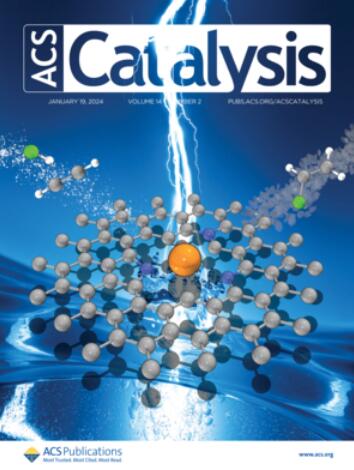Computationally Guided Development of an Alkene Aminocarboxylation with CO2: Synthesis of a β-Amino Acid Derivative
IF 11.3
1区 化学
Q1 CHEMISTRY, PHYSICAL
引用次数: 0
Abstract
β-Amino acids are important structural motifs in synthetic organic chemistry owing to their applications as components in artificial peptides, which are intensively studied in pharmaceutical science. While various strategies exist for synthesizing α- and γ-amino acids from CO2 via α-amino carbanion or α-aminoalkyl radical intermediates, direct and concise routes to β-amino acids remain rare. Herein, we report the computationally guided development of a photoredox-catalyzed aminocarboxylation of an aminoalkene with CO2, affording a β-amino acid derivative under mild conditions. Although the demonstrated scope is currently limited, this transformation showcases a mechanistically distinct reactivity pattern enabled by photoredox catalysis. The reaction was inspired by our previous multistate reaction path network explored for Knowles’ hydroamination, where we found that a seam of crossing (SX) point for the potential energy surface involving a CH3OH molecule facilitates product formation via proton-coupled electron transfer. Upon substituting CH3OH with CO2, the corresponding SX calculations indicated that the energetically concerted reduction–carboxylation mechanism is feasible. Indeed, cyclic β-amino acids were obtained from amino alkenes using [Ir(ppy)2(dtbbpy)]PF6 as a photoredox catalyst under irradiation with blue LEDs (440 nm). The developed photoreaction was successfully applied to a gas–liquid flow system under CO2 pressure (1.0 MPa), in which the blue LEDs irradiated the tube line (total volume: 4.6 mL) for merely 3.2 min to afford the desired β-amino acids in good yield.

以计算为导向的烯烃氨基羧化反应的发展:β-氨基酸衍生物的合成
β-氨基酸是合成有机化学中重要的结构基序,作为人工肽的组成成分,在制药科学中得到了广泛的研究。虽然通过α-氨基碳离子或α-氨基烷基自由基中间体从CO2合成α-和γ-氨基酸的策略多种多样,但直接和简洁的途径仍然很少。在此,我们报告了在计算指导下开发的光氧化催化的氨基羰基化与CO2,在温和的条件下提供β-氨基酸衍生物。尽管目前所展示的范围有限,但这种转化展示了一种由光氧化还原催化实现的机械上独特的反应模式。该反应的灵感来自于我们之前为Knowles’hydroamination探索的多态反应路径网络,在那里我们发现涉及CH3OH分子的势能表面的交叉(SX)点接缝有助于通过质子耦合电子转移形成产物。用CO2取代CH3OH后,相应的SX计算表明,能量协同还原-羧化机制是可行的。事实上,在蓝光led (440 nm)照射下,用[Ir(ppy)2(dtbbpy)]PF6作为光氧化还原催化剂,从氨基烯烃中获得了环β-氨基酸。所开发的光反应成功地应用于CO2压力(1.0 MPa)下的气液流动系统,其中蓝色led照射管道(总量:4.6 mL)仅3.2 min,以良好的产率提供所需的β-氨基酸。
本文章由计算机程序翻译,如有差异,请以英文原文为准。
求助全文
约1分钟内获得全文
求助全文
来源期刊

ACS Catalysis
CHEMISTRY, PHYSICAL-
CiteScore
20.80
自引率
6.20%
发文量
1253
审稿时长
1.5 months
期刊介绍:
ACS Catalysis is an esteemed journal that publishes original research in the fields of heterogeneous catalysis, molecular catalysis, and biocatalysis. It offers broad coverage across diverse areas such as life sciences, organometallics and synthesis, photochemistry and electrochemistry, drug discovery and synthesis, materials science, environmental protection, polymer discovery and synthesis, and energy and fuels.
The scope of the journal is to showcase innovative work in various aspects of catalysis. This includes new reactions and novel synthetic approaches utilizing known catalysts, the discovery or modification of new catalysts, elucidation of catalytic mechanisms through cutting-edge investigations, practical enhancements of existing processes, as well as conceptual advances in the field. Contributions to ACS Catalysis can encompass both experimental and theoretical research focused on catalytic molecules, macromolecules, and materials that exhibit catalytic turnover.
 求助内容:
求助内容: 应助结果提醒方式:
应助结果提醒方式:


